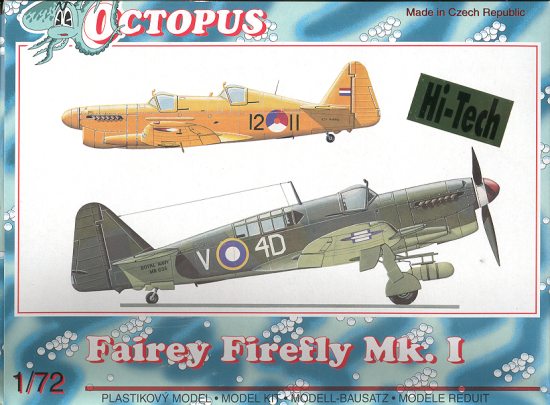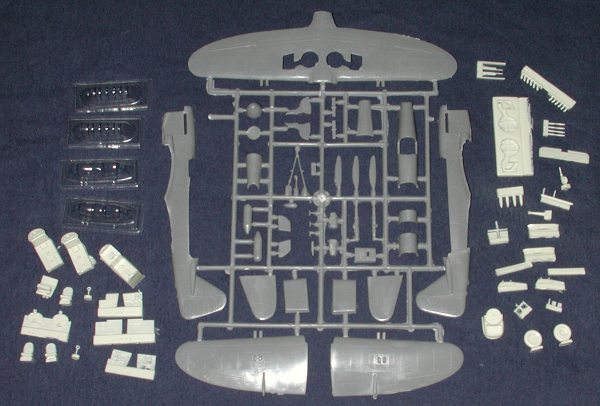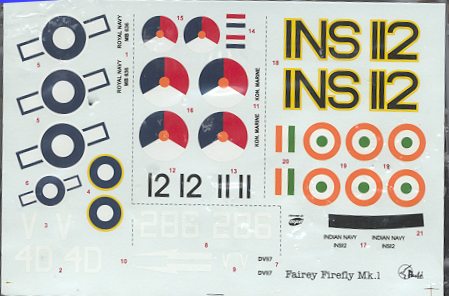
|
KIT: |
Octopus 1/72 Firefly I |
|
KIT # |
72039 |
|
PRICE: |
@$25 |
|
DECALS: |
Four aircraft |
|
REVIEWER: |
|
|
NOTES: |
Short run multimedia kit |

|
HISTORY |
The Firefly was built to specification N. 5/40 for the usual two seat fast naval fighter, a tradition with the FAA. The purpose was to combine a reconnaissance aircraft and fighter in one, hence the second crewman. The prototype first flew in December 1941 and was able to meet all of the requirements. This was as much due to its Griffon engine and clean airframe as anything else. With impressive firepower of four 20mm cannon, the Firefly was not only faster than the Fulmar by some 40 mph, but also able to land at a slower speed. This last trait was thanks to the large Fairey-Youngmann flaps that were fully retractable under the wings. In addition to acting as landing flaps, they could be extended straight back to improve maneuverability and cruise.
The first production plane was delivered in March of 1943 with the last of over 800 Firefly I's being delivered in November of 1946. Early Fireflies had a lower canopy, but complaints about difficulties in landing soon had a taller windscreen and canopy installed. A later modification to the Firefly included A.I. radar on a rack under the forward section of the airframe.
The first fleet squadron to use the Firefly was 1770 Squadron, which formed in October of 1943. It embarked on the Indefatigable was was operational over Norway in July 1944 against the Tirpitz. It also performed photo reconnaissance of the Tirpitz in August and September which helped lead to the sinking of this German battleship in November of 1944. Additional squadrons were formed, but it was the Far East where most of the Firefly activity was to take place. Initial attacks on Sumatra took place in January 1945 and until the end of the war, Firefly squadrons were in action against Japanese targets in the Dutch East Indies and other areas in the southwest and western Pacific. Fireflies produced no aces in air to air combat, but they were capable aircraft and did manage to knock down a few before the end of the war.
Post war the Firefly was used by a number of different countries including India, Netherlands and Ethiopia, to name but a few. Final British use of the Firefly I was with the R.V.N.R until 1950 when the last was retired.
|
THE KIT |

Upon opening the box, one is immediately impressed by the extent of the resin parts in this kit. There are two small bags that are absolutely full of resin bits. Cockpits, wheel wells, exhaust, racks and other various bits and pieces. Unfortunately, some of the finer bits had been broken as the parts jostled around in the bags. I do wish there was a way to keep this from happening, but unless one buys the kit at the factory door, I don't see any reasonable way of preventing this.
The base airframe is on a single sprue and is typical of current short run kits. Some parts have relatively large attachment points. Unfortunately, the fuselage halves were some of those parts and in breaking loose, now have large chunks where the sprues attached. The decal sheet also was unable to come through unscathed. Being in the bag with all those sharp bits on the sprue, it has several holes in it and is in otherwise poor shape.
Well enough on the packaging. The kit offers a number of different options. In fact, I dare say that there is not a Firefly I variant that cannot be built from this kit. That includes the trainer version, target tug version, and versions both with and without the search radar and/or wing mounted rockets. The resin parts are very well done and free from obvious imperfections and air bubbles. The kit also includes all the clear bits you need in vacuform. There are also two of each canopy type!! What's more, the plastic in the canopies is reasonably thick and not this flimsy stuff that sometimes accompanies short run kits. Makes it much easier to shape and glue.
The instructions are truly excellent. It is basically a 20 page booklet with a
history, parts layout, construction sequence and decal/camo section. There are
excellent color references  throughout
the construction sequence. Colors are given in generic as well as Humbrol colors
with FS numbers given where appropriate. Where there is a different variant to
do, that variant has its own small section for parts associated with that
variant.
throughout
the construction sequence. Colors are given in generic as well as Humbrol colors
with FS numbers given where appropriate. Where there is a different variant to
do, that variant has its own small section for parts associated with that
variant.
Markings are supplied for four aircraft. As I mentioned, the decals were rather badly damaged, though you should be able to piece together what you need. If that fails, there are several aftermarket sheets for this plane. Anyway, the first aircraft is the box art plane from 812 squadron in 1946 and is in the standard FAA colors. Also in FAA colors is the second scheme. This is a late war plane from 814 squadron and has a white flash on the nose. Next is a most colorful yellow T.1 of the Dutch navy post-war. Finally, a TT.1 target tug of the Indian Navy. This plane has a silver upper surface with yellow wing and fuselage band. The underside has large black and yellow stripes. Most colorful. The decals are well printed and have 'Pavla' printed on them, so we know who produces 'Octopus' kits!
|
CONCLUSIONS |
When you consider that the only other Firefly kit available in 1/72 is the now ancient Frog kit, this one is a quantum step above that one. It will probably require some patience and some of those modeling skills to complete, but anyone who is to the level of building one of these kits should not have any real problems with it.
|
REFERENCES |
British Naval Aircraft since 1912, Owen Thetford, 1978
If you would like your product reviewed fairly and quickly by a site that has well over 150,000 visitors a month, please contact me or see other details in the Note to Contributors.